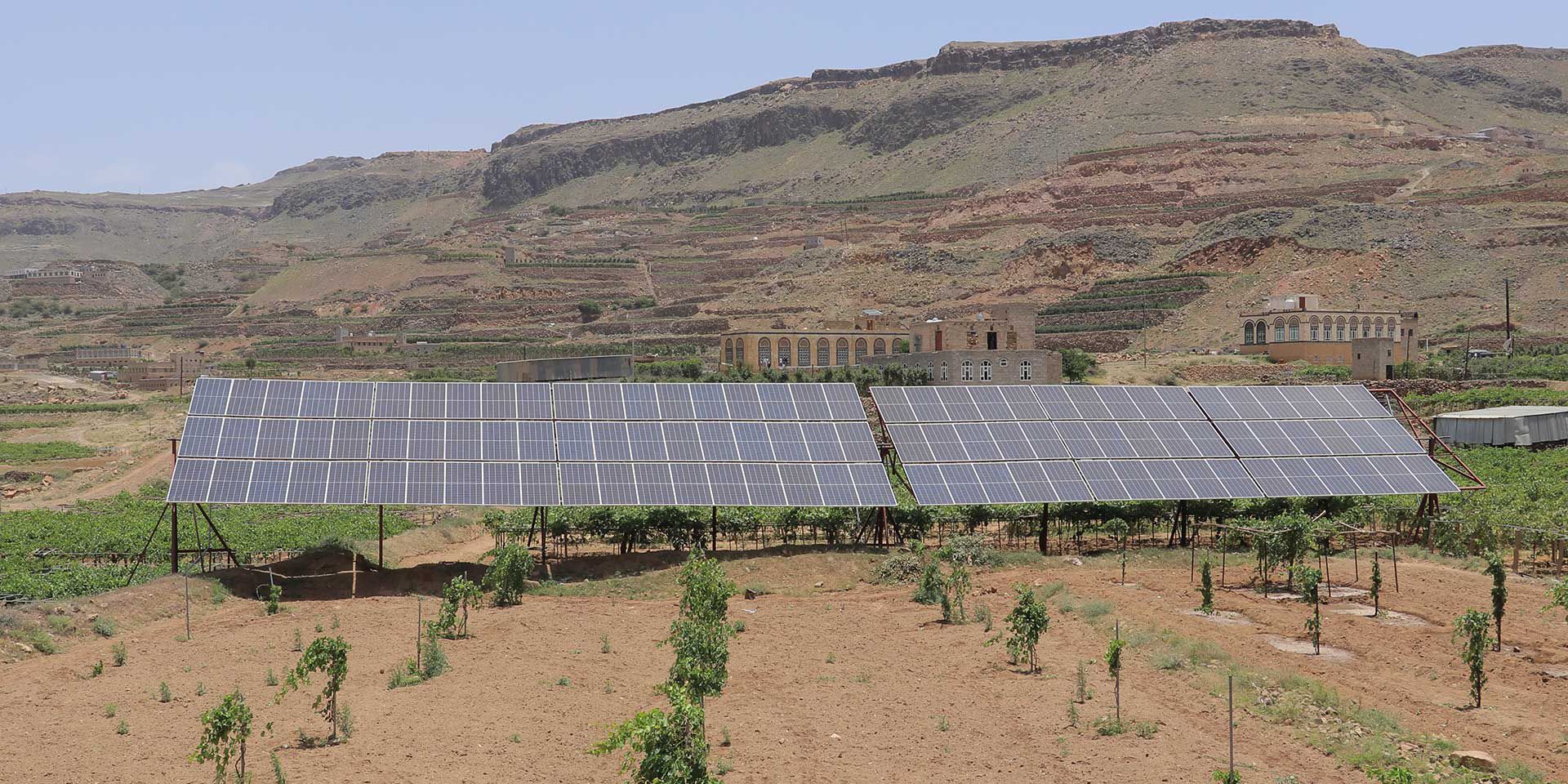By Andrew Raven
Farmer Bachir Mohamed Saleh Rassam is standing in his family vineyard, a ribbon of green set in the parched, rocky hills outside Sana’a, Yemen’s biggest city. The grapes are used to produce Yemen’s high-quality dried raisins—a key local commodity for both domestic use and export.
Not far away, amid orderly rows of grape vines, are seven clusters of solar panels. They power a pump that siphons water from an aquifer 1,000 metres below the surface, largely replacing an expensive and polluting diesel-fired generator Rassam had been using.
He says the setup, funded by a local lender, is a lifeline in an area that has been without power because of Yemen’s grinding conflict.
“We received financing for the system from Al Kuraimi bank and with the help of them, and God, we need much less diesel.”
Across Yemen, a growing number of farmers are turning to solar power to irrigate their fields, a shift that comes as the country tries to stave off what the United Nations warns is an impending famine.
The migration to solar power is part of what researchers say is an energy revolution in the country of 28 million, where the electric grid has been decimated by fighting. More than 50 percent of Yemeni households rely on the sun as their main source of energy, and solar arrays power everything from shops to schools to hospitals.
"For many in Yemen, especially for farmers, solar power has been a lifeline. The key now is to scale up its use."
“For many in Yemen, especially for farmers, solar power has been a lifeline,” says Matt Leonard, who specializes in microfinance with IFC. “The key now is to scale up its use.”
Yemen has long been the poorest country in the Middle East and North Africa, but a conflict that broke out in 2014 has pushed the country to the brink.
Fighting has left 80 percent of Yemenis at risk of hunger, according to the United Nations, and sparked a migration from cities, as residents seek safety and jobs in the countryside.
But a collapsing power grid—only 10 percent of Yemenis have access to central electricity—means that many farmers in Yemen’s arid hinterland rely on diesel generators to power wells.
Along with belching out greenhouse gases, farmers say the generators are expensive to run. The price of diesel in Yemen tripled between 2010 and 2016 and fuel is often impossible to find.
That has pushed farmers toward solar arrays. But the up-front costs can be high. Rassam paid about 50 million Yemeni rials (around $90,000 based on the unofficial market exchange rate) for his system, which is considered large by local standards. The average cost of an array is around $10,000.
Rassam financed the solar panels with a loan from Al Kuraimi Islamic Bank, one of the country’s largest private lenders. In recent years, the institution has ramped up lending to farmers, thanks in part to support from IFC.
In 2018, IFC began advising the bank, helping it gauge the market for solar power, refine its lending practices, and develop loan offerings tailored to farmers, homeowners and small businesses. IFC also connected Al Kuraimi with the makers of solar panels and other equipment, and helped the bank develop a screening mechanism to assure the systems they were financing were high quality.
The support is part of a larger IFC effort to fight poverty, create jobs and buttress infrastructure in fragile and conflict-affected states. During the last three fiscal years, IFC invested $2.4 billion in those countries and mobilized another $5.2 billion from other investors, while providing advice to legislators and private businesses.
“In many conflict-affected countries like Yemen, the private sector has been hobbled,” said Walid Labadi, IFC country officer for Yemen. “By helping businesses to grow, we can create jobs and economic opportunities—two things that are key to ending the cycle of violence.”
Since partnering with IFC, Al Kuraimi has financed 824 solar projects, including 406 water pumping stations on farms. The bank is now looking to expand by providing solar and hybrid solar-diesel systems to small businesses and manufacturers.
“There is tremendous demand for this type of financing,” says Taha Eskandar, the bank’s head for the microfinance sector. “It allows farmers to lower their expenses, increase their profits, and, at the end of the day, helps Yemen to produce the food it desperately needs during these challenging times.”
Farmer Mohamed Ahmad Sid El Rassam can attest to those benefits. He built a solar-powered water pump on his land in the region of Beni Hocheich. The setup chopped his diesel use by more than 85 percent, saving him 17 million Yemeni rials ($68,000) a year.
“With the solar system, we do not need diesel anymore,” said El Rassam, standing in front of a reservoir slowly filling with water. “We are thankful for the blessings of the sun.”
Published in January 2021
